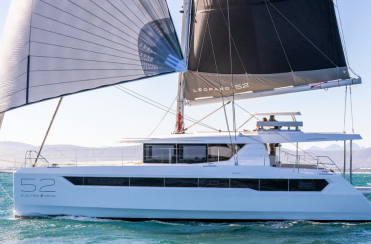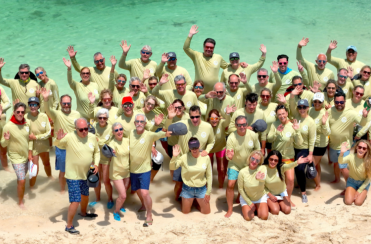
Taking your Powercat to a new cruising ground opens fresh horizons for exploration and fun. It’s really what boat ownership is about. And making the passage yourself can be an incomparable adventure.
But moving your boat is also more demanding than a weekend or vacation out-and-back trip. Once you get more than a day or two from your starting point, you need to be ready for a range of contingencies — you need a plan.
Power catamaran passage-making has a few different concerns than passages under sail, including fuel management. For insight on planning a Powercat passage, we spoke with Captain Calvyn McEvoy, an experienced delivery skipper and instructor.
There are two types of long passages – transiting stretches of coastline and crossing oceans. No matter where you’re headed, or the type of boat you’re moving, you must plan for the basics of food, water, fuel, stopping, weather, and routing. Weather and sea state impacts all boats, and will affect your Powercat’s fuel consumption and range.
Coastal Trips
Moving your Powercat from Ft. Lauderdale up to the Chesapeake or New England is a great way to discover new cruising grounds. It’s a multi-day adventure, most of which is spent on the Intracoastal Waterway (ICW). Being near the coast makes for an easier passage, with plenty of stopping places to refuel, take on supplies, and stop for the night.
Fuel management becomes more about planning refueling and knowing consumption rates, and less about having enough on board. Since you’ll be stopping most nights, you can restock and resupply along the way.
Crossing Oceans
Taking a new Powercat across the Atlantic, say from the construction boatyard in South Africa to Florida, is a big undertaking. We talked about one new owner’s delivery in a recent blog, and it can be a rewarding experience.
Heading offshore will compound your fuel planning needs. There aren’t many places to gas-up in the middle of the ocean. You need to carry a lot of extra fuel, and set your pace to maximize range.
“When I did trips from Cape Town to Bahamas,” says McEvoy, “we’d run those boats to get the best range, running one engine at a time at low RPM, making six to eight knots. You can get so much more range.”
Even with that, you’ll need to carry supplemental fuel and maintain very conservative speeds.
Fuel Planning
To effectively plan your trip, you need to know your boat’s capabilities and limits. While Leopard publishes Powercat cruising ranges, weather conditions and differences in load and trim on your boat will impact your actual range.
“Most stated ranges are for a bare boat with not much gear or water on board in flat water,” McEvoy points out. “Add in gear, full tanks, then waves and currents and you’ll be burning more fuel than what’s written on paper.”
Once you’ve owned your boat for a while, you’ll have a better sense of how much fuel it uses at various speeds. Take notes as you learn and keep a log, so you have accurate information instead of guesses or estimates. If you have a fuel flowmeter, keep detailed records of speed, RPMs, conditions and fuel consumption for future reference.
Daily Run Plan
Once you know your daily range, research where you can stop, and where you can refuel. You might not need to refuel daily, but taking on fuel should always be top of mind. If you plan to stop in marinas, you’ll need reservations. Anchoring out for the night gives you more flexibility about when you stop and where.
Plan your stops to be near places where you can easily refuel. Calculate your planned average speed, and how many hours per day you will travel.
Professional delivery crews on time sensitive deliveries may run round the clock and plan 300 mile days or longer while traveling offshore, even on coastal trips. But a Powercat owner with their family or a few friends heading up the ICW might aim for a more relaxed pace, moving eight or ten hours a day or less.
“Taking a Powercat down the ICW isn’t so difficult,” McEvoy tells us. “But I wouldn’t recommend doing it at night. There are too many shallows, markers, channels, and things you can’t see.”
Know Your Fuel Stops
“Time your trip by the anchorages and stops,” says McEvoy. “Pick secondary ports and pre-plot them. Plan your fallback ports; those things matter.”
Familiarize yourself with multiple stopping options along your route. Plot multiple route forks to alternative places you can pull in if you can’t make that day’s destination. You don’t want to be searching for a safe place if you’ve got mechanical issues, bad weather catches you, or you just need to stop moving.
Know where to find fuel near each fallback port, and make a note of the phone numbers so you can call ahead if you have to make an unplanned stop.
Fuel Saving Tips
Running your boat for optimal fuel consumption takes a little experience, and sometimes a bit of trial and error.
Leopard has fuel consumption curves for your boat, and those can help you look for the right RPMs and boat speed to maximize your range. But as Captain McEvoy observed, those numbers are for light ship test conditions, and your mileage will vary. They’re still worth studying, because they show you how fuel consumption changes as you push the throttle. But test your own boat with specific loads and engine RPMs.
Finding the right speed
Many boats find their most efficient speed somewhere around 80% of full throttle. Most have low consumption rates at low RPMs, but as you rev the engine, fuel consumption increases.
Captain McEvoy tells us, “You might make six to eight knots while flat in the water with low RPMs. But if you increase your speed to ten to twelve knots, all of a sudden, the stern starts to squat and the boat makes bigger waves. Fuel consumption goes up a lot.”
At that point, the boat is displacing lots of water and burning lots of fuel for its speed. But, McEvoy adds, “when you push it to get to fourteen to sixteen knots the boat gets up and planes and is more efficient.”
Check your bottom
Before you set out on a passage, get your Powercat’s bottom and propellers cleaned. If you can’t haul out for a power wash, clean the bottom in the water. Growth creates drag that requires more power and fuel to overcome. You might not feel slower, but your boat will use more fuel to maintain your preferred cruising speed if the bottom or propellers are dirty.
Save weight
A heavier boat takes more power and fuel to move at the same speed. So if you are stopping at night, think about not filling the water tanks every day. Consider how much gear you really need for the journey. Less weight equals more fuel savings and better range.
Preparations
Make a checklist of tasks before your trip. This should cover food and meals, navigation, emergency routines and a watch schedule. Give yourself time to plan and prepare. A long trip – even a coastal one – isn’t something you decide to do on the spur of the moment.
Engine Service
Begin with a fresh oil change, clean fuel filters, and inspect the engines to ensure all fluids are topped up. If you exceed the service interval for your oil change on your trip, you’ll need to do one along the way. So it’s better to start with a fresh change. Inspect everything, including all replaceable components like impellers, and make sure you have spares.
Courses and Routes
Plan your entire course before you go. It will probably change once you move, but a full route from the start means you know where you’re going, you’re just making adjustments as you go along instead of preparing all new navigation.
As Captain McEvoy mentioned above, plan alternate stops along the way. Know where you can pull in for fuel, spares, food, and even water and other supplies.
Refueling Plan
For most coastal passages, you’ll be able to get in and out of fuel docks pretty easily. But you should still check ahead to make sure the approaches work for your boat. Use Google Earth to see just how you need to gain entrance, and plot a course all the way to the dock.
It’s a good idea to carry a few spare jugs of diesel along on any long trip. Make sure you know how you’re going to get the fuel from the jerry can to the fuel tank. Pouring with a spout is messy and tricky even with a funnel. A small electric pump will do the job nicely. Siphons work well if you can get the can above the fuel port.
Aim for safe, but have some fun
Safety is always a priority, but you’re on a large, stable, and luxurious Powercat. You should have a great time. A long passage doesn’t have to be a grind. Pace coastal trips to explore the places you stop, plan good meals, and leave time to see the waters you’re moving through. Nothing says you can’t add a lay day if you find someplace special.
A Powercat passage requires a great deal of thought and planning. And, if you do it right, getting there can be more than half the fun!
-1.png?width=1200&height=600&name=Untitled%20design%20(38)-1.png)
-4.png?width=1200&height=600&name=Untitled%20design%20(44)-4.png)
-1.png?width=1200&height=600&name=Untitled%20design%20(40)-1.png)
-1.png?width=1200&height=600&name=Untitled%20design%20(42)-1.png)
-3.png?width=1200&height=600&name=Untitled%20design%20(43)-3.png)


